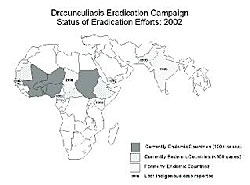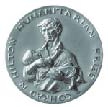This article originally appeared in the Spring 2003 issue of Humanitarian Affairs Review. Reprinted with permission
Fighting the scourge of Guinea worm
The Guinea worm parasite causes devastating disease, with far reaching consequences for development. But eradication, even in many remote regions, is within reach. Roger Phillips, Nigeria Program Consultant at The Carter Center, describes how basic hygiene and larvicide are putting end to suffering
We followed a line of women, each carrying a basin on her head, along a dry, dirt path through the yam fields near the Nigerian village of Etenyi. Arriving at a small pond, we saw one elderly woman standing on the bank among a group of villagers. Out of her foot emerged the whitish strand of a Guinea worm.
We quickly asked the woman to move away from the pond. "Anyone with Guinea worm disease must not come to the pond," I said as Moses, the Nigerian field officer, translated for the villagers. "If she puts her foot in the water, anyone drinking this water risks getting the same disease."
Guinea worm disease struck 39 people in this village the previous month. Their open, infected sores and swollen ankles and legs kept them from taking part in the planting season for yams - a critically important time for the village economy.
After discovering the disease here, we immediately distributed cloth filter pipes, which people wear round their necks and use for drinking water. Today we had come to search out and treat ponds with the chemical ABATE® Larvicide to destroy the Guinea worm larvae. One worried man asked, "Will the Abate kill the fish, too?" I assured him that would not happen, but his question prompted us to go to the village chief's house to explain the work we were doing. Once the chief understood our mission, he showed us a pond we had missed. Another discovery during this visit proved to be even more fortunate.
We spotted a polyvinyl chloride pipe jutting up from the ground close to the road. When Moses dropped a small stone down the shaft, we heard the splash of water. Once we had installed a $300 pump, the villagers no longer had to rely on two muddy ponds as their best source of water.
The village elders can hardly believe my assurances that these combined efforts may see the end of this crippling disease in Etenyi, within perhaps two years.
Agonising process
People contract Guinea worm disease when they ingest water contaminated with water fleas carrying infective larvae. By the time a thread-like, whitish Guinea worm burns a hole from inside, breaks through the skin, and forms a sore on the person carrying it, it has lived in them for about a year. Traditionally, the infected person wraps the Guinea worm around a small stick and extracts it by rolling the two- to three-foot-long worm on it, a slow, agonising process that takes many weeks. The burning sensation caused by the worm's emergence causes victims to immerse themselves in water for relief. This is usually a pond used as the local drinking supply where the worms release thousands of new larvae, perpetuating the cycle of infection.
 Guinea worm disease cripples victims, leaving them unable to work, attend school, care for their children, or harvest crops. Lesions that develop can lead to severe secondary bacterial infections that incapacitate individuals and dramatically reduce productive activity. Eradicating, or at the very least reducing, the incidence of Guinea worm disease in a country improves the quality of life of the entire population. The Carter Center helps to provide the three essential ingredients for a successful eradication campaign – political will, financial support, and technical expertise.
Guinea worm disease cripples victims, leaving them unable to work, attend school, care for their children, or harvest crops. Lesions that develop can lead to severe secondary bacterial infections that incapacitate individuals and dramatically reduce productive activity. Eradicating, or at the very least reducing, the incidence of Guinea worm disease in a country improves the quality of life of the entire population. The Carter Center helps to provide the three essential ingredients for a successful eradication campaign – political will, financial support, and technical expertise.
Brink of extinction
Dracunculiasis, or Guinea worm disease, is a 3,000 year-old parasitic disease endemic in remote regions of the world's least developed countries. At the beginning of the 20th century, Guinea worm disease was widespread in many countries in Africa and Asia. Today, the numbers of Guinea worm disease cases have been reduced worldwide by 98%: from 3.5m cases in 1986 to less than 65,000 cases reported in 2001. The Carter Center leads the global campaign to eradicate Guinea worm disease in 13 remaining African countries. The armed conflict in Sudan presents the final challenge to end the disease, with this war-torn country accounting for nearly 80% of the cases reported in 2002.
In the history of mankind, only one disease, smallpox, has been eradicated. Through the efforts of a worldwide coalition led by The Carter Center and with the generous support of our partners, such as the Conrad N. Hilton Foundation, this debilitating disease is poised to become the second.
To learn more about The Carter Center's work to wage peace, fight disease, and build hope, please visit www.cartercenter.org

By the time a thread-like, whitish Guinea worm burns a hole from inside, breaks through the skin, and forms a sore on the person carrying it, it has lived in them for about a year

The Conrad Hilton Foundation is a partner with The Carter Center.
Please sign up below for important news about the work of The Carter Center and special event invitations.